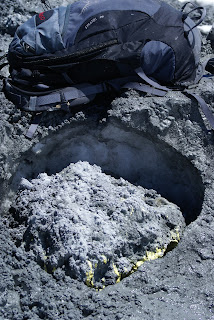

Fox glacier is located near the west coast of the South Island of New Zealand. It is 6-8 kilometres in length, blue in colour, striated, and covered with sediment. There are four essential elements to creating and maintaining a glacier, high precipitation, wind, snow, and elevation. Tectonic activity is essential because it allows for the high elevation. The alpine fault pushes the mountains up; giving Fox Glacier the elevation it needs to survive. The valley is V-shaped and has nearly-vertical rock faces created by the advancement of the glacier. Seracs, which are created when ice movement slows, piles up on itself and fractures, are visible at the top of the glacier. The debris and rocks carried by glaciers create lateral and terminal moraines. These rocks are haast schist grading into gneiss as they get closer to alpine fault. Throughout our visit we saw many boulders falling off the face of Fox Glacier, showing how unstable and unsafe it is to be near glaciers. Water melts from the ice carrying a lot of sediment and finds a path out, the melt water flow is called end glacier tunnels. The flow is constantly changing between calm and raging; a high flow rate allows movement of huge boulders. Large floods can occur if “plumbing” is backed up and has a sudden release of water; this is called a jokallahap. Surging glaciers are also able to advance fast down valley because the pressure of melt water under the glacier forces it to de-stick from bedrock, allowing it to surge down valleys hundreds of metres. Dead ice, which is ice left behind because a glacier moving so fast, is also visible at Fox Glacier. This ice can survive for decades because it is buried in outwash, providing insolation. Kettle lakes are circular lakes that form around dead ice. An alluvial fan formed in the valley from glacier advancement which previously kept the sediment in place. The waterfalls visible throughout the valley are created by hanging valleys. Waterfalls are typical geological feature of glacial locations because side valleys hang above the main valley, which is eroded faster because it has more ice than side valleys. My 2 pictures are of Fox Glacier 1 year apart. Some of the most obvious differences are there is more sediment on the glacier November 2007, since December 2006 a lot of the snout has melted, the velocity of the melt water in December 2006 was a lot stronger, there appears to be a lot more snow accumulation on top of the glacier in November 2007, and the seracs are more defined in November 2007.
photo on left: Fox Glacier November 2007
photo on right: Fox Glacier December 2006
-By: Jordan Silletti






















.jpg)


























